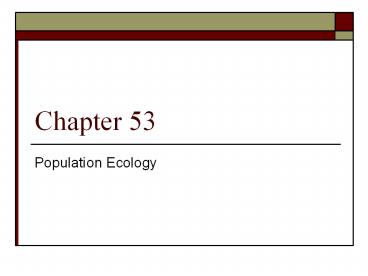Population Ecology - PowerPoint PPT Presentation
Title:
Population Ecology
Description:
Chapter 53 Population Ecology Population Dynamics Changes that occur in: Population size Density Dispersion Age distribution due to environmental change or stress. – PowerPoint PPT presentation
Number of Views:149
Avg rating:3.0/5.0
Title: Population Ecology
1
Chapter 53
- Population Ecology
2
Population Dynamics
- Changes that occur in
- Population size
- Density
- Dispersion
- Age distribution
- due to environmental change or stress.
3
Population Size
- Limits to population growth
- (births immigration) (deaths emigration)
- Carrying capacity (k)-- of individuals that an
environment can sustain indefinitely determined
by - Biotic potential (maximum capacity for pop.
growth) - Environmental resistance (all factors that limit
growth) - G r x
N - (growth over time) (rate of increase) (pop
size)
4
Types of Growth
- Exponential growth (J-shaped curve)
- Logistic growth (S-shaped curve) pop levels off
around carrying capacity.
5
Types of Growth (cont)
- Boom and Bust
- Population overshoots carrying capacity, then has
dieback (death/emigration).
6
Reproductive Strategies
- r-selected species
- Opportunist insects and rodents.
- Many, small young.
- Reproduce early and often.
- Little parental care most young die.
- High pop growth rate (r).
- K-selected species
- Competitor large mammals and birds.
- Few, larger young.
- Reproduce later and not as often.
- Care of young most survive.
- Stable pop size near carrying capacity (k).
7
Survivorship Curves
- Different reproductive patterns lead to different
age structures in the population. - Late loss (green) K-selected species.
- Early loss (red) r-selected species.
- Constant loss (black)
8
Human Population History
9
Factors affecting birth rates
- 1. Children needed to work.
- 2. Living in urban areas.
- 3. Cost of raising kids.
- 4. Opportunities for women.
- 5. Infant mortality.
- 6. Ave age of marriage.
- 7. Pensions.
- 8. Legal abortions.
- 9. Birth control.
- 10. Religious beliefs.
10
Factors affecting death rates
- 1. Increased food supply.
- 2. Better nutrition.
- 3. Improved health care/technology.
- 4. Improved sanitation/hygiene.
- 5. Safer water supplies.
11
Age Structure Diagrams
- shows the proportion of the population of each
sex at each age level. - Looks at 3 age categories
- 0 to 14 yrs (pre-reproductive)
- 15 to 44 yrs (reproductive)
- 45 (post-reproductive)
- (number of women impacts fertility rates)
- Can be used predict population growth and study
economic impact.
12
Predicting Populations
- Rapid growth (Kenya) large numbers of younger
people. - Slow growth (US)
- Zero or negative growth (Sweden) small numbers
of young people.































